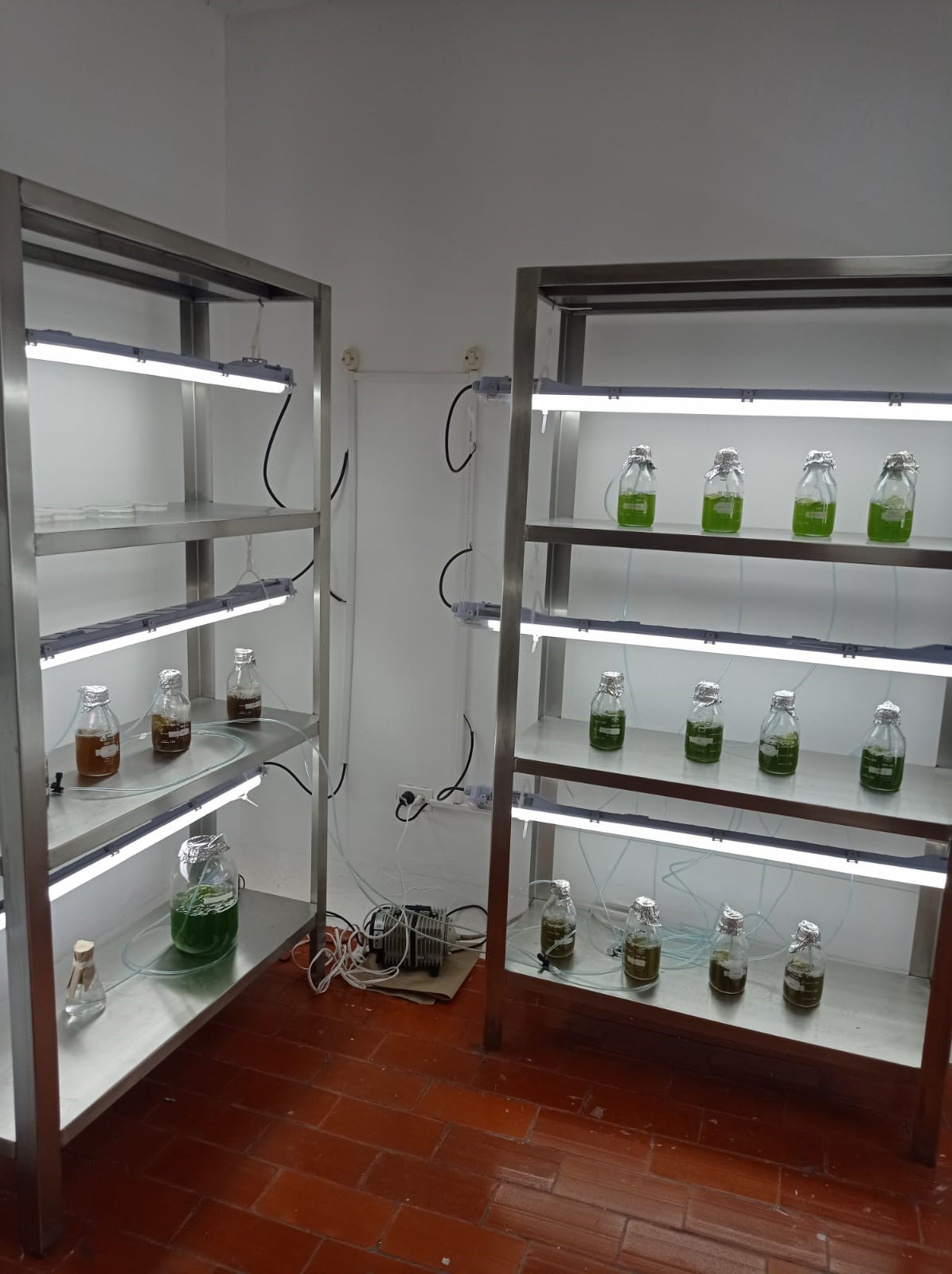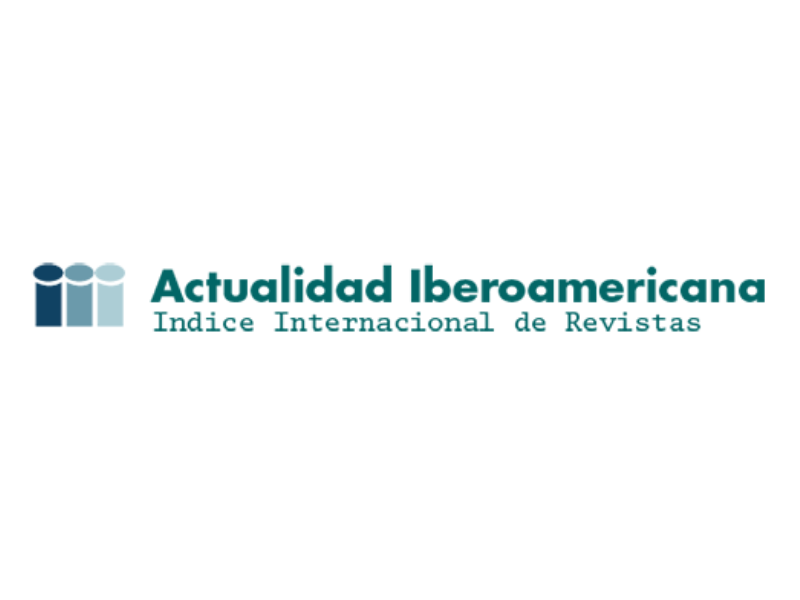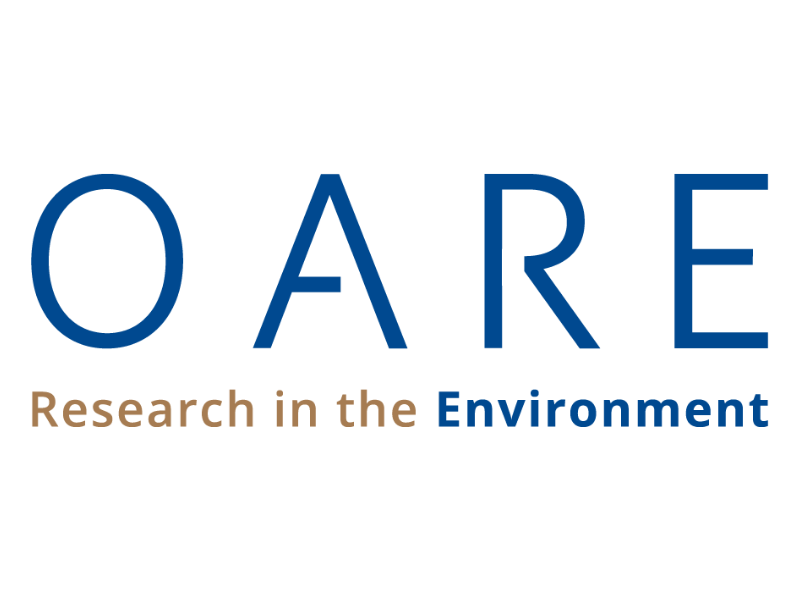Efecto de lixiviado sobre el crecimiento de consorcios de microalgas marinas y dulceacuícolas
Effect of leachate on the growth of marine and freshwater microalgae consortia

Esta obra está bajo una licencia internacional Creative Commons Atribución-NoComercial-CompartirIgual 4.0.
Mostrar biografía de los autores
Objetivo. En este estudio se evaluó la cinética de crecimiento de consorcios de microalgas marinas y de agua dulce en diferentes concentraciones de lixiviado extraído de un relleno sanitario. Materiales y métodos. Se realizó un diseño experimental por cada consorcio (marina Chlorella marina y Nannochloropsis oculata y de agua dulce Chlorella vulgaris y Ankistrodesmus falcatus) en concentraciones de lixiviado de 5, 10, 15% y un control (0%), con una inóculo principal y tres réplicas para cada concentración (K=4), en cultivo discontinuo. Resultados. Se encontraron diferencias significativas en el crecimiento microalgal a distintas concentraciones de lixiviado para los dos consorcios utilizados (H=12.9768; p<0.05 para microalgas marinas y H=20.0097; p<0.05 para microalgas dulceacuícolas), debido principalmente a un mayor crecimiento en el grupo control. También se encontró una correlación negativa significativa (p<0.01) entre la tasa de crecimiento y la división celular con la concentración de lixiviado, observándose un menor crecimiento en concentraciones superiores al 5% en ambos consorcios. Conclusiones. El consorcio marino logró generar mayor densidad celular, por lo que podría incrementar la efectividad de los procesos de biorremediación de contaminantes, a pesar del efecto negativo observado en mayores cantidades del compuesto.
Visitas del artículo 262 | Visitas PDF
Descargas
- El Ouaer M, Turki N, Kallel A, Halaoui M, Trabelsi I, Hassen A. Recovery of landfill leachate as culture medium for two microalgae: Chlorella sp. and Scenedesmus sp. Environ Dev Sustain. 2019; 22:2651– 2671 https://doi.org/10.1007/s10668-019- 00314-7
- Nawas T, Rahman A, Pan S, Dixon K, Petri B, Selvaratnam T. A Review of Landfill Leachate Treatment by Microalgae: Current Status and Future Directions. Processes. 2020; 8(384). https://doi.org/10.3390/pr8040384
- Porto B, Gonçalves AL, Esteves AF, De Souza SMA, De Souza, AAU, Vilar VJP, et al. Assessing the potential of microalgae for nutrients removal from a landfill leachate using an innovative tubular photobioreactor. Chem Eng J. 2020. https://doi.org/10.1016/j.cej.2020.127546
- Carrizales LT, Panca CMA. Evaluación del impacto de la contaminación de los residuos sólidos sobre suelo y agua del botadero sanitario de Cancharani–Puno. Ñawparisun. 2020; 2(4):29-36. https://unaj.edu.pe/ revista/index.php/vpin/article/view/104
- Baldiris-Navarro I, Virviescas M, Aponte, J. Evaluación del uso de la microalga Chlorella vulgaris como Biorremediadora de vertimientos de la Industria Acuícola en el Caribe colombiano. Teknos. 2019; 19(1):10- 15. https://doi.org/10.25044/25392190.988
- Hao T B, Balamurugan S, Zhang Z H, Liu S F, Wang X, Li D W, et al. Effective Bioremediation of Tobacco Wastewater by Microalgae at Acidic PH for Synergistic Biomass and Lipid Accumulation. J. Hazard. Mater. 2022; 426:127820. https://doi. org/10.1016/j.jhazmat.2021.127820.
- Priya A K, Jalil A A, Vadivel S, Dutta K, Rajendran S, Fujii M, et al. Heavy metal remediation from wastewater using microalgae: Recent advances and future trends . Chemosphere . 2022; 305:135375. https://doi.org/10.1016/j. chemosphere.2022.135375
- Vo H N P, Ngo H H, Guo W, Liu Y, Chang S W, Nguyen D D, et al. Identification of the pollutants removal and mechanism by microalgae in saline wastewater. Bioresour Technol. 2019; 275:44-52. https://doi. org/10.1016/j.biortech.2018.12.026
- Sousa H, Sousa CA, Simões LC, Simões M. Microalgal-based removal of contaminants of emerging concern. J Hazard Mater. 2022; 423:127153. https://pubmed.ncbi.nlm.nih. gov/34543999/
- Cobos M, Estela S, Castro C, Grandez M, Tresierra A, Cabezudo C, et al. Potential of Native Microalgae from the Peruvian Amazon on the Removal of Pollutants. Progress in Microalgae Research - A Path for Shaping Sustainable Futures. IntechOpen; 2022. http://dx.doi.org/10.5772/ intechopen.105686
- Viegas C, Nobre C, Mota A, Vilarinho C, Gouveia L, Gonçalves, M. A circular approach for landfill leachate treatment: Chemical precipitation with biomass ash followed by bioremediation through microalgae. J Environ Chem Eng. 2021; 9(3):105187. https://doi.org/10.1016/j. jece.2021.105187
- Zhao X, Zhou Y, Huang S, Qiu D, Schideman L, Chai X, et al. Characterization of microalgae-bacteria consortium cultured in landfill leachate for carbon fixation and lipid production, Bioresour Technol. 2014; 156:322-328. https://doi.org/10.1016/j. biortech.2013.12.112
- Infante C, Angulo E, Zárate A, Florez J Z, Barrios F, Zapata C. Propagación de la microalga Chlorella sp. en cultivo por lote: cinética del crecimiento celular. Av Cien Ing. 2012; 3(2):159-164. https://www. executivebs.org/publishing.cl/avancesen-ciencias-e-ingenieria-vol-3-nro-2-ano2012-articulo-16/
- Ruiz-Martinez A, Martin N, Romero I, Seco A, Ferrer J. Microalgae cultivation in wastewater: nutrient removal from anaerobic membrane bioreactor effluent. Bioresour Technol. 2012; 126:247-253. https://doi. org/10.1016/j.biortech.2012.09.022
- Torres M, Sánchez J. Avances del Banco de Cepas de Microalgas en el Centro Internacional Náutico Fluvial y Portuario del SENA. Rev SENNOVA, 2016; 2(1):30-41. https://revistas.sena.edu.co/index.php/ sennova/article/view/536
- Forero-Cujiño M A, Montengro, L C, Pinilla-Agudelo G A, Melgarejo-Muñoz L M. Immobilization of microalgae Scenedesmus ovalternus (Scenedesmaceae) and Chlorella vulgaris (Chlorellaceae) in calcium alginate beads. Acta Biol Colomb. 2016; 21(2):437- 442. https://doi.org/10.15446/abc. v21n2.51253
- Ramos R, Pizarro R. Crecimiento y capacidad de biorremediación de Chlorella vulgaris (Trebouxiophycea, Chlorophyta) cultivada en aguas residuales generados en el cultivo del pez dorado Seriola lalandi (Perciformes: Carangidae). Rev Biol Mar Oceanogr. . 2018; 53(1):75-86. http://dx.doi.org/10.4067/ S0718-19572018000100075
- Das C, Ramaiah N, Pereira E, Naseera K. Efficient bioremediation of tannery wastewater by monostrains and consortium of marine Chlorella sp. and Phormidium sp. Int J Phytoremediation. 2018; 20(3):284- 292. https://doi.org/10.1080/15226514.2 017.1374338
- Hu D, Zhang J, Chu R, Yin Z, Hu J, Kristianto Y, et al. Microalgae Chlorella vulgaris and Scenedesmus dimorphus co-cultivation with landfill leachate for pollutant removal and lipid production. Bioresour Technol. 2021; 342:126003. https://pubmed.ncbi.nlm.nih. gov/34571333/
- Coulson JP, Torres MJ, Henao-Castro A, Díaz, G X. Evaluación del potencial de cultivo de cuatro especies microalgales nativas del departamento de Bolívar, Colombia. Rev Mutis. 2022; 12(2). https://doi. org/10.21789/22561498.1821
- Arredondo B, Voltolina D, Zenteno T, Arce M, Gomez G. Métodos y herramientas analíticas en la evaluación de la biomasa microalgal 2da edición. La Paz: Centro de Investigaciones Biológicas del Noroeste; 2017.
- Mishra P, Pandey C M, Singh U, Gupta A, Sahu C, Keshri A. Descriptive statistics and normality tests for statistical data. Ann Card Anaesth. 2019; 22(1):67-72. https://doi. org/10.4103/aca.ACA_157_18
- Nahm F S. Nonparametric statistical tests for the continuous data: the basic concept and the practical use. Korean J Anesthesiol. 2016; 69(1):8-14. https://doi.org/10.4097/ kjae.2016.69.1.8
- Dinno A . Nonparametricpairwise multiple comparisons in independent g r o u p s u s i n g D u n n ’ s t e s t . S t a t a J. 2015; 15(1):292-300. https://doi. org/10.1177/1536867X1501500117
- Rebekić A, Lončarić Z, Petrović S, Marić S. Pearson’s or Spearman’s correlation coefficient-which one to use?. Poljoprivreda. 2015; 21(2):47-54. https://doi. org/10.18047/poljo.21.2.8
- Suchéras-Marx B, Escarguel G, Ferreira J, Hammer Ø. Statistical confidence intervals for relative abundances and abundancebased ratios: Simple practical solutions for an old overlooked question. Mar Micropaleontol. 2019; 151:101751. https:// doi.org/10.1016/j.marmicro.2019.101751
- Gonçalves A, Pires J, Simoes M. A review on the use of microalgal consortia for wastewater treatment. Algal Res. 2017; 24(B):403-415. https://doi.org/10.1016/j. algal.2016.11.008
- Jacome C, Ballesteros C, Rea E, Rea L, Poma P. Microalgas en el tratamiento de aguas residuales generadas en industrias de curtiembres. Cienc Tecn UTEQ. 2021; 14(2):47-55. https://doi.org/10.18779/cyt. v14i2.502
- Peleg M, Corradini MG, Normand MD. The logistic (Verhulst) model for sigmoid microbial growth curves revisited. Food Res Int. 2007; 40(7):808-818. https://doi. org/10.1016/j.foodres.2007.01.012
- Paskuliakova A, McGowan T, Tonry S, Touzet N. Microalgal bioremediation of nitrogenous compounds in landfill leachate – The importance of micronutrient balance in the treatment of leachates of variable composition. Algal Research . 2018; 32:162–171. https://doi.org/10.1016/j. algal.2018.03.010
- Vitola D, Pérez A, Montes D. Utilización de microalgas como alternativa para la remoción de metales pesados. RIAA. 2022; 13(1):195-203. https://doi. org/10.22490/21456453.4568 32. Baran T, Sargin I, Kaya M, Menteş A, Ceter, T. Design and application of sporopollenin microcapsule supported palladium catalyst: Remarkably high turnover frequency and reusability in catalysis of biaryls. Colloid Interface Sci. 2017; 486:194–203. https:// doi.org/10.1016/j.jcis.2016.09.071
- Liu X, Hong Y, Gu W. Influence of light quality on Chlorella growth, photosynthetic pigments and high-valued products accumulation in coastal saline-alkali leachate. Water Reuse. 2021; 11(2):301-311. https://doi. org/10.2166/wrd.2021.088
- Nambukrishnan V, Singaram J. Enhanced biodiesel production by optimizing growth conditions of Chlorella marina in tannery wastewater. Fuel. 2022; 316:123431. https:// doi.org/10.1016/j.fuel.2022.123431
- Shaari AL, Che Sa SN, Surif M, Zolkarnain N, Ghazali R. Growth of Marine Microalgae in Landfill Leachate and Their Ability as Pollutants Removal. Trop Life Sci Res. 2021; 32(2):133-146. https://doi.org/10.21315/ tlsr2021.32.2.9
- Al Dayel M F, El Sherif F. Evaluation of the effects of Chlorella vulgaris, Nannochloropsis salina, and Enterobacter cloacae on growth, yield and active compound compositions of Moringa oleifera under salinity stress. Saudi J Biol Sci. 2021; 28(3):1687–1696. https:// doi.org/10.1016/j.sjbs.2020.12.007
- Mitra M, Mishra S. Effect of glucose on growth and fatty acid composition of an euryhaline eustigmatophyte Nannochloropsis oceanica under mixotrophic culture condition, Bioresour. Technol. Rep. 2018; 3:147–153. https://doi.org/10.1016/j. biteb.2018.07.013
- Marques I M, Oliveira A C V, de Oliveira O M C, Sales E A, Moreira Í T A. A photobioreactor using Nannochloropsis oculata marine microalgae for removal of polycyclic aromatic hydrocarbons and sorption of metals in produced water. Chemosphere. 2021; 281:130775. https://doi.org/10.1016/j. chemosphere.2021.130775
- Hernandez-Perez A, Jabbé JI. Microalgas, cultivo y beneficios. Rev Biol Mar Oceanogr. 2014; 49(2):157-173. https://doi. org/10.4067/S0718-19572014000200001
























